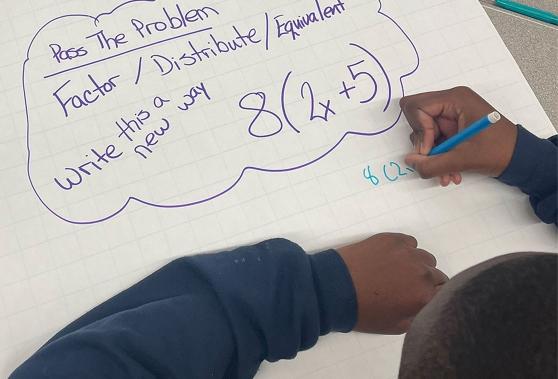
When students work on problems their classmates created, it boosts engagement.
Practice is critical to learning and skill retention. As a middle school math teacher, I’ve learned that providing students with spiral reviews — having students revisit concepts throughout the year — created by their peers instills a sense of ownership of the work. It typically makes the problems more relatable to their lives and bridges the gap between theory and the real world.
To review for a big unit test, I have students create review stations. Our current unit, for example, has eight subparts, so each of the eight small groups is in charge of designing a review station for their designated subpart. I give the groups one class period to create the problems to be solved, as well as define vocabulary words that correspond with their subpart. On review day, I give the groups a few minutes to set up their stations, and then students circulate with their group through the other stations to work on solving their classmates’ problems in their notebooks.
I also like to do an activity called “Pass the Problem,” which starts at the end of a lesson. For an exit ticket, I ask the students to create a problem based on the day’s learning standard and then solve the problem, showing the steps. I collect the problems.
At a later date, perhaps prior to the unit test, I use those student-created questions as practice or review. All students are given back the problem they created, without the steps to solve it, placed in the center of a piece of chart paper. Each student is given a marker of a different color.
Depending on the type of problem, I set a timer for anywhere from 90 seconds to four minutes. When I say “go,” the students pass their problem on the chart paper to their neighbor and each student works on the new problem in front of them. When the teacher calls “time,” they pass that problem to their neighbor. For each round, every student is solving a different problem created by a fellow student. Depending on the length of the class, the students solve as many of their classmates’ problems as possible. I’ve found that students don’t usually have the impulse to look at the previous solutions, but another strategy is to pass out large sticky notes and have students cover their work before they pass the chart paper on.
When the time is up, each student gets back the problem they created. The chart paper is now filled with all of their classmates’ work. They spend a few minutes using the three-point New York state rubric to score each of their classmate’s responses. Finally, students use a sticky note to give feedback, a “glow and a grow,” on a fellow classmate’s created problem; for example, “The story problem you made was fun, but the numbers were way too big to be good practice.” The teacher, who knows which marker color each student had, gathers up the chart papers and uses the solved problems to assess student comprehension.
What I’ve seen with student-created review stations and Pass the Problem is more student buy-in. The students are excited to see their authentic work, and it helps them retain the new information better.
Lori McDonald is a middle school math teacher at MS 53 in Queens.